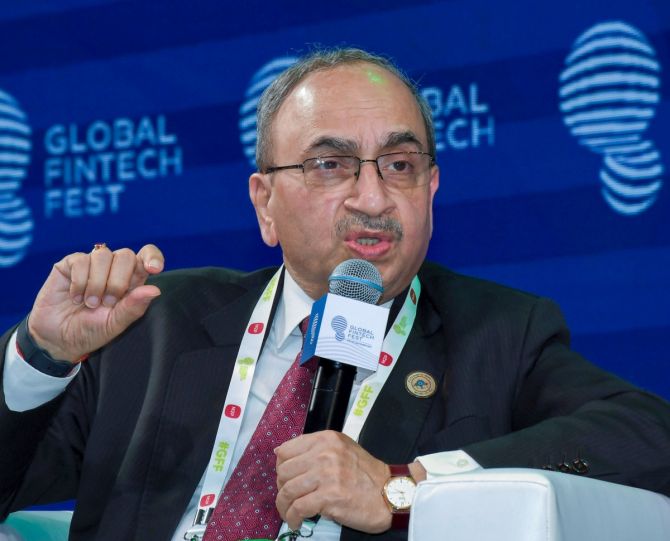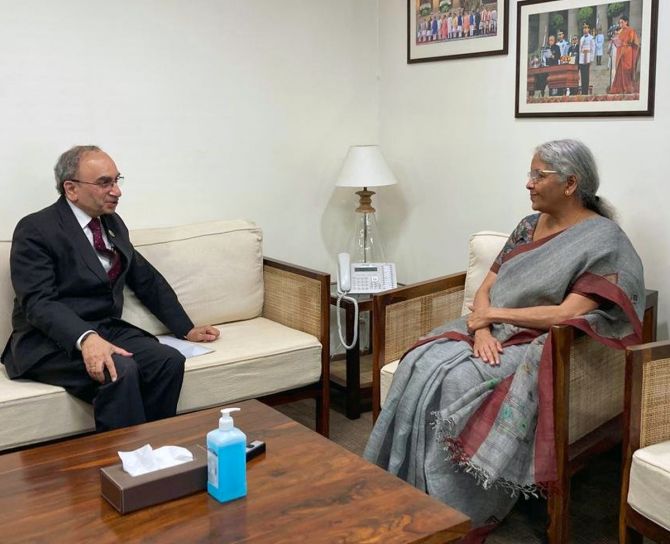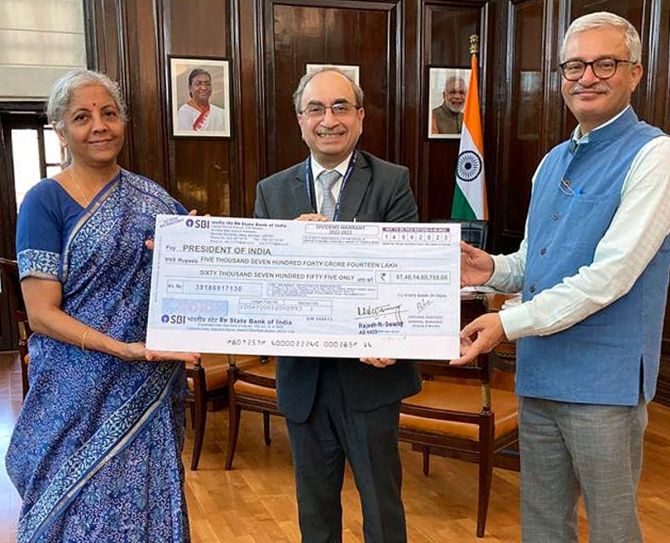'This year in the first half we had profits of more than Rs 31,000 crore.'
'We have a plan to plough back a significant amount of profits this financial year.'
'We have seen this organic plough back of profit is one of the best ways to support the equity of the bank.'

Dinesh Khara, chairman, State Bank of India, exudes confidence about the demand for wholesale loans as the bank has a sanction pipeline of Rs 4.7 trillion.
In an interview with Manojit SahaBusiness Standard, Khara says SBI has a plan to plough back a significant part of its profit this financial year, and that would increase the capital adequacy ratio by 140 basis points.
The US Federal Reserve has indicated there could be rate cuts this year. Do you think the RBI would also in a position to reduce the repo rate from 2024?
The RBI is focused on looking at the domestic inflation rate, which is still over 5 per cent.
We have seen in the past also that as far as our monetary policy is concerned, it is quite decoupled vis-a-vis the US.
Yes, it is positive that the Fed has indicated there are likely to be three rate cuts.
We are hoping that maybe from the middle of this financial year we will get to see some reduction in interest rates. But it will be subject to the inflation trajectory moving towards 4 per cent. We will wait and watch closely on how things evolve.
How do you see the central bank's move to do a variable rate repo (VRR) auction at a time when liquidity is expected to tighten?
This is a very pragmatic approach. The RBI does not want to unnecessarily impact the system because advance tax is a reality and it will certainly lead to outflows.
Just to maintain adequate liquidity in the system -- this appears to be a step in the right direction.
The RBI has increased risk weightinging on unsecured loans. While that may not have any significant implication for banks because they are well capitalised, what is the message from the regulator?
The message is very clear. Growth is good. But the effort should be for healthy growth.
Unhealthy growth can have a negative impact on the economy, which is not intended.
This message has to be read in the context that pre-Covid unsecured credit was subject to 125 per cent risk weighting.
During Covid this was brought down to 100 per cent. Now that Covid is behind us, we have gone back to 125 per cent.

Do you expect some slowdown in the growth of unsecured loans?
Unsecured loans were growing at a very fast pace, 30 to 33 per cent, for the system.
We have purposely slowed them down, and they have come down to about 18 per cent.
We expect we will grow at that pace because we don't want unhealthy growth in this particular segment.
Are you planning to slow loans to non-banking financial companies (NBFCs) because risk weightinging has increased in that segment too?
It is not that we have slowed them. We have a portfolio of about Rs 3 trillion.
Of this a very significant portion -- about Rs 2.7 trillion -- is to very well-rated NBFCs.
Some of them are government-owned, and others are supported by very strong industrial groups.
We have been very conscious while lending to NBFCs. We have strengthened our underwriting practices for quite some time.
I will mention that of late even the RBI has strengthened its oversight and has come up with guidelines on NBFCs, which actually enhances the confidence of the lending community.
So I think it will not have any impact on us, but the increase in risk weighting will mean the cost of credit will go up for the NBFCs, depending on the kind of risk.
Has SBI increased lending rates for unsecured loans and after the RBI increased the risk weighting?
The matter will be deliberated in the asset-liability committee and a decision will be taken.

What will be the impact of SBI's capital position due to the increase in risk weightinging?
We have assessed that the overall impact of the increase in risk weighting for NBFCs and unsecured loans put together comes to 70 basis points.
SBI's credit growth till September was robust at 12.4 per cent. Do you think the trend will continue for the remaining part of the financial year?
I hope so. Because when I review my daily numbers, I see a traction which is more on those lines, which gives me confidence that perhaps we will continue to see growth around those numbers, maybe a little better also.
What is the projection for credit growth this financial year?
I expect it to be somewhere in the range of 14 to 15 per cent.
SBI's credit-deposit (CD) ratio is around 71 per cent. Do you expect that to go up?
If we look at our domestic CD ratio, it is around 66 per cent.
If we look at domestic and overseas, it is around 72 per cent. It might improve by about 100 basis points or so.
How has been the demand for wholesale loans?
We have a pipeline of Rs 4.7 trillion. That is a clear reflection that people have evaluated investment opportunities and are seeking sanctions for proposals. But this number will not show up immediately as far as credit growth is concerned.
A majority of them are term loans, which will be disbursed over time. And also there is always a lag between sanction and disbursement.
The more important indicator would be the investment commitments companies have made.
In 2022-2023, the investment commitment was Rs 35 trillion. In 2021-2022 it was Rs 22 trillion.
This year, in the first half, it is Rs 20 trillion. This augurs well in terms of the likelihood of investments getting reflected in the bank's loan books. But it gets spread over a period of time.
SBI's deposit growth was healthy at 12 per cent. There are certain private sector banks which are also aggressive in getting deposits. Are you conscious about competition from private banks? Will you be able to hold on to your market share?
Our effort is to stay ahead of competition. We have tweaked our interest rates in different buckets.
That is based on our own assessment where depositors are likely to keep their money.
We feel confident that we would be able to maintain our market share.

Do you think deposit re-pricing is over? If not, what would be the impact on the margins?
There would be an impact of 3 to 5 basis points (on the margins) because major portions of deposits have been accounted for.
This was essentially done in the one-year bracket. So the maximum impact would be 3-5 basis points on the net interest margins.
There was been significant improvement in asset quality. Both the gross and net non-performing asset (NPA) ratios fell in the second quarter. Do you see scope for further improvement?
Our effort will be to keep the net NPA ratio where it was and improve it if possible.
It is a constant effort by the bank to improve wherever there is scope for doing so.
What is the amount of bad loans SBI plans to sell to asset reconstruction companies in the remaining part of the financial year?
Much depends on the kind of offers. All options are evaluated, and based on those we will take a call on deriving maximum value.
For the current year, we had a recovery budget of Rs 18,000 crore (Rs 18 billion) and hopefully we should be on track.
Coming to capital, SBI's capital adequacy ratio was 14.28 per cent as on September 30. Do you see any need to raise equity capital this financial year?
Last financial year, we had profits of Rs 50,000 crore (Rs 500 billion), of which we ploughed back Rs 40,000 crore (Rs 400 billion).
The year prior to that we made profits of Rs 32,000 crore (Rs 320 billion) and we had ploughed back Rs 25,000 crore (Rs 250 billion).
This year in the first half we had profits of more than Rs 31,000 crore (Rs 310 billion).
We have a plan to plough back a significant amount of profits this financial year also.
We have seen this organic plough back of profit is one of the best ways to support the equity of the bank.
If we succeed in doing that, with the numbers we have in mind, I would say our capital adequacy will go up by 140 basis points.
Anyway, we have approval from the board to raise Tier-I capital of Rs 20,000 crore (Rs 200 billion), of which Rs 13,000 crore (Rs 130 billion) we have already raised. And we will be raising the remaining amount this financial year.
You have completed three years as chairman. What are your unfinished tasks that you want to take up on priority?
Yono 2.0 is unfinished. We are working on that. It is a work in progress and an ambitious project.
I expect in four-six months we should be in a position to see some early minimum viable projects.
It is a continuous improvement of our existing Yono. There would be some incremental improvement and some path-breaking improvement.
Feature Presentation: Rajesh Alva/Rediff.com











